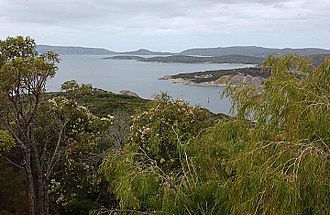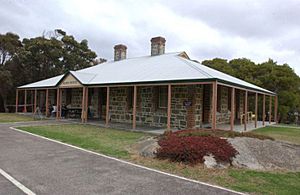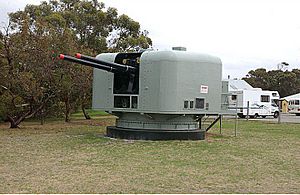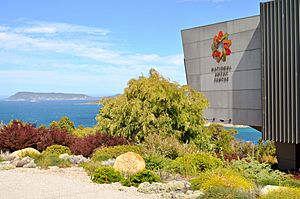Princess Royal Fortress facts for kids
Quick facts for kids Princess Royal Fortress |
|
|---|---|

View from fortress to King George Sound and Atatürk entrance
|
|
| General information | |
| Type | Heritage listed fortress |
| Location | Albany, Western Australia |
| Coordinates | 35°01′50.6″S 117°54′40.5″E / 35.030722°S 117.911250°E |
| Type | State Registered Place |
| Designated | 29 November 1996 |
| Reference no. | 26 |
The Princess Royal Fortress, also called the Albany Forts, is an old military fort located in Albany, Western Australia. It sits on Mount Adelaide, looking out over King George Sound and Princess Royal Harbour. Today, this historic place is a popular museum.
Contents
About the Princess Royal Fortress
Why it's Called Princess Royal Fortress
The fortress gets its name from Princess Royal Harbour. A famous explorer named George Vancouver named the harbour way back in 1791. He named it after a princess called Charlotte Augusta Matilda. The whole area where the fort is built covers about 11 acres.
Building the Fortress
In the 1800s, people worried that if the port was attacked, it would be a big problem for Australia. So, all the Australian states worked together to pay for the fortress. The British Government also helped by providing the big guns.
This fortress was the very first defense project for Australia as a whole. This happened even before Australia had its own federal government! The fort officially opened in 1893. Two main gun areas were built into the hillside of Mount Adelaide. These were Fort Princess Royal and Fort Plantagenet.
Fort Princess Royal and Fort Plantagenet
Fort Princess Royal had two large 6-inch guns. Fort Plantagenet had one 6-inch gun. These guns were ready to protect the harbour.
Fires and Changes Over Time
In 1897, a fire started on purpose destroyed some buildings. These included the canteen, mess-room, and library. All these buildings were made of wood with metal roofs.
By 1902, the fortress had eight officers and five soldiers working there.
Another fire broke out in 1907 at the western end of the forts. This fire burned down the office, the weapons room, and the stationery locker.
In 1909, the gun at Fort Plantagenet broke. It was removed, and Fort Plantagenet was no longer used. The other guns were replaced with newer ones in 1945.
The Guns Never Fired in Battle
From 1893 until 1956, the guns at the fortress never fired a single shot in a real battle. By 1956, new weapons like missiles made old coastal forts less important. So, all coastal defenses, including Princess Royal, were closed down. Many of the military buildings were taken apart or destroyed.
After the fort closed, some buildings were used as school rooms. Later, they became places for new people coming to Australia to stay. Then they were holiday camps. By the 1970s, the site was left empty and was damaged by people.
Bringing the Fortress Back to Life
Work to fix up the fortress started in 1987. This restoration continued through the rest of the 1980s.
Eventually, the site became a museum. Inside the fortress grounds, you can see restored military equipment. This includes old shore batteries, places where weapons were stored, and soldier's living areas. There's also a display about the 10th Light Horse, walking trails, and a collection of naval guns and torpedoes.
The site also has special memorials. These include the South East Asia Memorial, the United States Submariners Memorial, and the Merchant Navy Memorial. More than 25,000 visitors come to the fortress every year.
What You Can See Today
Two of the original guns are still in their places. There's also an underground magazine for storing ammunition. You can see old ruins, some buildings that have been rebuilt, and a parade ground. The Military Institute, Guard House, Barracks, and Repository Store are all around the parade ground. Other buildings are placed depending on the land.
The National Anzac Centre
The entire fortress area was greatly improved for the Anzac centenary in 2015. The National Anzac Centre was built for about $10.65 million. It opened on November 1, 2014. The Prime Minister of Australia, Tony Abbott, and the Prime Minister of New Zealand, John Key, were there for the opening. This date was special because it marked 100 years since the first Australian and New Zealand soldiers left Albany for war.
The National Anzac Centre was named the best Heritage Tourism Project in Western Australia in 2015. In its first three months, about 25,000 people visited the center. Over 45,000 people visited in its first six months.
By September 2016, the center was ranked as Australia's number one museum by users of TripAdvisor. Since it opened, it has welcomed 136,000 visitors.
Engineering Heritage Award
The battery and magazine at the fortress received a special award. It was a Historic Engineering Marker from Engineers Australia. This award is part of their program to recognize important engineering history.
See also




